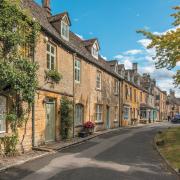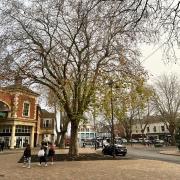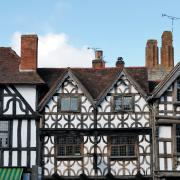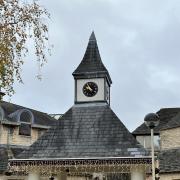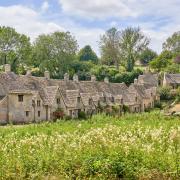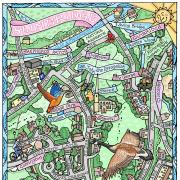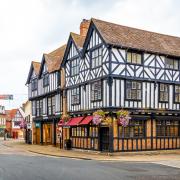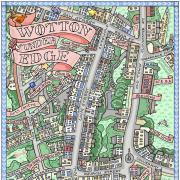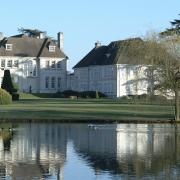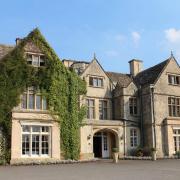You don’t need green fingers to appreciate the beauty of a Cotswold garden at the height of summer. Here are a few of our favourites to get you started...
Now, I love a good garden, but I’m no gardener. I understand my position in the horticultural pecking order and I am very much the Under Gardener to Mrs Steve’s Head Gardener. While she’s daintily dead-heading, pruning, or positioning colour-coordinated bedding plants I’ll be shoving more peelings in the compost bin or maybe mowing the lawn if I’ve been promoted. We Brits love our gardens and there’s nowhere better to find inspiration for our plots than by touring the best the Cotswolds has to offer. So, in a departure from my usual history bag I’m off to explore our best gardens. History won’t be entirely forgotten as I’m interested in how gardens became what they are today, when they were established, by whom, and how they’ve changed.

Sudeley Castle (Lady Ashcombe and family)
Just south of Winchcombe is Sudeley, which is, of course, the only private castle in England with a queen buried in its grounds (Catherine Parr) but this time I’m focused rather on the ten magnificent, award-winning gardens that we can gain ‘aha moments’ from. Admire the purple allium providing a splash of colour against the castle’s stark stonework. Trimmed yews lie among formal gardens, shielding the pinnacled chapel where a queen reposes.
sudeleycastle.co.uk (Castle Kitchen Pantry and Terrace Café)

Westbury Court (National Trust)
Controversy reigns at Westbury-on-Severn, near Gloucester, as to whether there was Dutch influence. A ‘Dutch’ style implied courtyards with ornamental canals, topiary, myrtle, oleander (tubbed) and oranges. Yes, you needed canals to create Amsterdam in the Cotswolds. At Westbury people still argue about how much Dutchness there is. Created between 1690-1702 by Maynard Colchester, who had a Dutch neighbour incidentally, it has a canal stretching from pavilion to fountain. There’s ‘walled spaces’ (a.k.a. courtyards), clipped pyramids and shrubs (topiary maybe) and a plethora of fruit trees. Why, there were even tons of bulbs brought over from Holland and we can still explore 17th-century veg patches. The 1960s saw this become one of the National Trust’s first garden restoration projects as other Cotswold gardens followed Hidcote’s lead (below) in being bestowed on the Trust.
nationaltrust.org.uk/westbury-court-garden

Bourton House Garden (privately owned)
At the bottom of the hill that’s in ‘Bourton-on-the-Hill’, lies Bourton House, of fine 18th century stock, which is blessed with one of the most remarkable 16th century tithe barns anywhere in Gloucestershire and an award-winning three-acre garden with a late summer flourish. We can walk in the neighbouring seven-acre field where specimen trees were planted over 1994-95.
bourtonhouse.com (café, and 2-for-1 offer if you also visit Batsford Arboretum in 2022)

Sezincote (privately owned)
Also near Bourton-on-the-Hill, at the head of the Evenlode, is ‘India in the Cotswolds’, where the garden was inspired by Humphry Repton, the man who inherited the early landscape gardening mantle from Capability Brown. Repton went exotic at Sezincote, creating something extraordinary for owner Sir Charles Cockerell. The water garden, completed around 1803, is fab, although Mrs Steve, an ophidiophobe, might not dilly-dally at the Snake Pond, albeit the snake is of the statuesque persuasion. This is a Regency garden, grand yet grotesque (in a good way), a bit of the Prince Regent’s Brighton Pavilion in Gloucestershire (except Sezincote inspired Brighton).
sezincote.co.uk (Orangery Tea Room)

Kelmscott (Society of Antiquaries of London)
William Morris, pioneer of Arts and Crafts, was also an advocate of old gardens. His ideal June garden (‘News from Nowhere’) was based on Kelmscott Manor, the old farmhouse at Lechlade, where he spent his summers from 1871 on the upper Thames. His friend Georgiana Burne-Jones, wife of Pre-Raphaelite artist Edward Burne-Jones, visited near the end of Morris’ time and praised his creativity: ‘The garden is enchanting with flowers, one mass of them, and all kept in beautiful order’. ‘Mass’ and ‘order’ are interesting words to combine in the same sentence methinks. Morris gave clues as to how this might work in an 1879 lecture, saying that whatever size a garden, it could look ‘orderly and rich’ (a tidy mass in other words). He also recommended it being ‘well fenced from the outside world’. I took Morris’ advice recently after a neighbour climbed into my garden and chopped back a load of my bushes in an apparent rush of blood to his noggin. I’ve now erected a nice solid fence; thanks for the tip Will. Morris didn’t think the gardener’s job was to imitate or improve on nature but to create something you’d only expect to find close to a house. He went further: ‘It should in fact look like part of a house’. The garden as an extension of house is nothing new. There’s barns, meadow and stream, and a dovecote, whilst Morris lies buried under the shade of an evergreen.

Batsford Arboretum (The Batsford Foundation)
There’s a wide range of plants from around the world with a Far East bias at 55-acre Batsford, which was established by Algernon Freeman-Mitford after he’d inherited the estate in 1886. It’s held the National Collection of Japanese Flowering Cherries since 2002 and also participates in the International Conifer Conservation Project run by Edinburgh’s Royal Botanic Garden.
batsarb.co.uk (garden centre & shop, Garden Terrace Café and Roger the woodturner)

Hidcote (National Trust)
Morris’ influence spread to Hidcote where its own Arts and Crafts inspired gardens are delightful, intricately designed with a myriad of pathways, bashful sculptures, vistas to die for amid secret gardens, with something to drool over around corners or down nooks and crannies. What I really like about them though is that they’re among the early-20th century’s most original. They weren’t created by a professional designer from a tried and tested formula but were conjured by the owner, the American Major Lawrence Johnston. He set to in 1907, starting to lay out his garden on fields described as ‘windswept’ and dedicated the next 40 years to improving it step by step until donating it to the National Trust in old age. Of the Trust’s many gardens this was the first to be accepted on its own merits rather than because it was the garden that accompanied a grand house. It was transformative. After Hidcote the Trust began accepting other worthy gardens. Johnston dealt with the wind by planting lots of trees, supplementing these with hedges, everything from copper beech and yew to holly and hornbeam. Those hedges divided the garden into compartments or ‘rooms’ which became a popular concept in the future as the garden came to be seen as an extension of home. Johnston was no amateur as he was a plantsman who knew his stuff having been on plant collecting trips around the globe. His creation merges imperceptibly into the surrounding countryside from which it’s separated by a hidden ha-ha. It’s always good to have a laugh.
nationaltrust.org.uk/hidcote (Winthrop’s Café and shop)

Snowshill Manor (National Trust)
Near Broadway, Arts and Crafts looms large again as another devotee was at work here, the architect Mackay Hugh Baillie Scott who developed that notion of house and garden as one. It was 1920 when Scott flourished his initial garden design for Snowshill for the eccentric and eclectic collector of ‘stuff’ Charles Wade, another architect, who’d recently purchased the place as his country pile.
nationaltrust.org.uk/snowshill-manor-and-garden (café and shop)

Kiftsgate Court (Family run)
Near Chipping Campden is the birthplace of the Kiftsgate rose, which is an arching beauty of monstrous proportions and grows amongst the garden’s borders, flowering a spectacular white in early-July, blooms cascading groundward like a weeping willow. Kiftsgate resembles Hidcote because that man Lawrence Johnston wove his magic here too as he assisted his mates the Muirs but the gardens are truly the legacy of three lady gardeners starting with founder Heather Muir, then Diany Binny, and finally Anne Chambers.
kiftsgate.co.uk (tearoom, plants and gift shop)
Broughton Grange (privately owned)
Broughton Grange’s history dates back to 1620 when it began as a small farm cottage associated with Broughton Castle, the site developed overtime into an estate in its own right. The gardens’ development really took off from 2001 with spectacular designs by multiple Chelsea Flower Show gold medallist Tom Stuart-Smith within a six-acre walled site. There’s also an 80-acre arboretum, one of the largest recent plantings in the UK.
broughtongrange.com (light refreshments and plant nursery)
MORE COTSWOLD GARDENS
Rodmarton (Biddulph family)
Rodmarton Manor (Glos) is another Arts and Crafts manor, built for Claud and Margaret Biddulph between 1909-29 with an eight-acre garden containing ‘Outdoor Rooms’ each with its own individual character. It’s particularly beautiful in the summer months.
rodmarton-manor.co.uk (Rare Plant Fair – June 19, 2022)
Cerney (privately owned)
Near Cheltenham, Cerney House Gardens is set around a Victorian walled garden and includes a Knot Garden, herb and veg garden.
cerneygardens.com (self-service refreshments)
Painswick Rococo Garden (Painswick Rococo Garden Trust)
It’s the UK’s only complete surviving Rococo garden, replete with hidden valley, play area with maze for the kids to vanish in, follies, and walks through woods, and is to be found at Painswick House (1737).
rococogarden.org.uk (café and shop)
Studley Castle (Warner Leisure Hotels)
Studley (Warwicks) shouldn’t be confused with Sudeley. Daisy Warwick, Mistress of the Prince of Wales (‘Bertie’ the future Edward VII), shifted her agricultural college for ladies here, which had been established in Reading in 1898. Five years later the women rocked up at Studley (with patronage by the now King Edward VII). The castle had been built in 1834.
warnerleisurehotels.co.uk
Abbey House Gardens (privately owned)
Malmesbury Abbey was the burial place of Alfred the Great’s grandson, Aethelstan, oft regarded as the first unifying King of England. Well, he’s buried somewhere amidst these lovely gardens where a couple of saints were also chucked down the well.
Miserden (family run)
Near Stroud, Miserden comprises 850 acres within an AONB (Area of Outstanding Natural Beauty). There’s woodland, gardens and farmland which together offer a sanctuary for hard-pressed wildlife.
miserden.org (café)
Highgrove (Their Royal Highnesses The Prince of Wales & Duchess of Cornwall)
South west of Tetbury lies the historic late-18th-century estate that is, of course, Prince Charles’s country home which he purchased in 1980. The garden has been redeveloped under his stewardship with a new project being undertaken each year. Wisteria, honeysuckle, jasmine and thyme all abound and there’s an experimental wildflower meadow with more than 30 varieties of endangered native plants being nurtured, plus an exotic ‘Carpet Garden’ where the ground literally disappears.
highgrovegardens.com (The Orchard Tea Room and the Highgrove Estate Shop)
Westonbirt Arboretum (Forestry England)
The National Arboretum is sited about three miles south west of Tetbury and is home to some 2,500 different species from around the world.
forestryengland.uk (café, picnic area, shop and visitor centre)
Bibury Trout Farm (privately owned)
Founded in 1902 by the famous naturalist Arthur Severn, the trout farm is England’s longest established working trout farm and is set in beautiful grounds of 15 acres.
biburytroutfarm.co.uk (café, shop, fishery and Crazy Golf)
Highnam Court (privately owned)
Built in 1658 after the original house was damaged in the English Civil War, it’s one of the few country houses built during the Commonwealth. The 40-acre gardens have been restored to their former glory over the last quarter century.
highnamcourt.co.uk
References
- The Mail on Sunday – Holidays (26/12/2021)
- National Trust Handbook, 2022
- A Little History of British Gardening (J Uglow, 2004)
- The Shell Guide to England (Ed. J Hadfield, 1973)
- Bolthole Retreats (boltholeretreats.co.uk)
- National Trust (nationaltrust.org.uk)
- Highgrove Gardens (highgrovegardens.com)
- Rodmarton Manor (rodmarton-manor.co.uk)
- Sezincote (sezincote.co.uk)
- Broughton Grange (broughtongrange.com)
- Cerney House Gardens (cerneygardens.com)
- Batsford Arboretum (batsarb.co.uk)
- Painswick Rococo Garden (rococogarden.org.uk)
- Bourton House Garden (bourtonhouse.com)
- Kiftsgate Court (kiftsgate.co.uk)
- Sudeley Castle (sudeleycastle.co.uk)
- Warner Leisure Hotels (warnerleisurehotels.co.uk)
- Miserden (miserden.org)
- Kelmscott (sal.org.uk/kelmscott-manor)
- Trip Advisor (tripadvisor.co.uk)
- Explore Gloucestershire (exploregloucestershire.co.uk)






